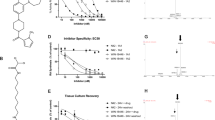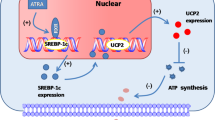Abstract
OBJECTIVE: To investigate whether retinoid X receptor agonists act as insulin sensitizers and compare their effects with that of thiazolidinedione BRL 49653 in obese Zucker rats.
DESIGN: In two independent studies, obese Zucker rats were dosed orally once daily for 14 days with one of the following treatments: LG 100268 (20 mg/kg), LG 100324 (20 mg/kg), BRL 49653 (3 mg/kg) or vehicle.
MEASUREMENTS: Daily food intake and body weight gain, blood glucose, plasma and pancreatic insulin, whole body glucose disposal (by euglycaemic–hyperinsulinaemic clamp) and tissue glucose utilization.
RESULTS: The retinoid X receptor agonists (rexinoids) LG 100268 and LG 100324 caused a reduction in the food intake of obese Zucker rats relative to controls and to rats receiving BRL 49653. The two rexinoids also produced a marked decrease in the body weight gain, whereas the growth rate of rats treated with BRL 49653 tended to increase. Both rexinoids and BRL 49653 reduced the plasma insulin concentration of fed rats. LG 100268 and LG 100324 also significantly lowered blood glucose concentrations after 1 week of treatment. The 5 h fasted plasma insulin concentration was significantly lower in the rexinoid-treated groups and the terminal insulin level (at the end of the clamp) tended to be lower in all treated groups compared with animals given the dosing vehicle. However, pancreatic insulin content was not affected by any of the treatments. Under euglycaemic–hyperinsulinaemic clamp conditions, there were no significant differences in the rate of hepatic glucose output and whole body glucose disposal, except that, in experiment 1, BRL 49653 caused significant increase in the glucose infusion rate and muscle glucose utilization. In experiment 2, a similar glucose infusion rate to the controls was achieved in all treatment groups but the steady-state insulin concentration in the treated animals was only about 50% of that in the control animals, despite the fact that all rats received a similar insulin infusion concentration. This suggests that both the rexinoids and BRL 49653 increased insulin clearance.
CONCLUSIONS: Chronic administration of retinoid X receptor agonists LG 100268 and LG 100324 to Zucker fa/fa rats reduces food intake and body weight gain, lowers plasma insulin concentrations while maintaining normoglycaemia, indicating an improvement of insulin sensitivity.
This is a preview of subscription content, access via your institution
Access options
Subscribe to this journal
Receive 12 print issues and online access
$259.00 per year
only $21.58 per issue
Buy this article
- Purchase on Springer Link
- Instant access to full article PDF
Prices may be subject to local taxes which are calculated during checkout








Similar content being viewed by others
References
Lemberger T, Desvergne B, Wahli W . Peroxisome proliferator-activated receptors: a nuclear receptor signaling pathway in lipid physiology Annu Rev Cell Dev Biol 1996 12: 335–363.
Mandrup S, Lane MD . Regulating adipogenesis J Biol Chem 1997 272: 5367–5370.
Mangelsdorf DJ, Evans RM . The RXR heterodimers and orphan receptors Cell 1995 83: 841–850.
Lehmann JM, Moore LB, Smith-Oliver TA, Wilkison WO, Willson TM, Kliewer SA . An antidiabetie thiazolidinedione is a high affinity ligand for peroxisome proliferator-activated receptor gamma (PPAR gamma) J Biol Chem 1995 270: 12953–12956.
Forman BM, Tontonoz, P, Chen J, Brun RP, Spiegelman BM, Evans BM . 15-Deoxy-delta 12,14-prostaglandin J2 is a ligand for the adipocyte determination factor PPAR gamma Cell 1995 83: 803–812.
Young PW, Buckle DR, Cantello BC, Chapman H, Clapham JC, Coyle PJ, Haigh D, Hindley RM, Holder JC, Kallender H, Latter AJ, Lawrie KWM, Mossakowska D, Murphy GJ, Cox LR, Smith SA . Identification of high-affinity binding sites for the insulin-sensitizer rosiglitazone (BRL-49653) in rodent and human adipocytes using a radio-iodinated ligand for peroxisomal proliferator-activated receptor gamma J Pharmacol Exp Ther 1998 284: 751–759.
Mukherjee R, Davies PJA, Crombie DL, Biselhoff ED, Cesario RM, Jow L, Hamann LG, Boehm MF, Mondon CE, Nadzan AM, Paterniti JR Jr, Heyman RA . Sensitization of diabetic and obese mice to insulin by retinoid X receptor agonists Nature 1997 386: 407–410.
Kraegen EW, James DE, Bennett SP, Chisholm DJ . In vivo insulin sensitivity in the rat determined by euglycemic clamp Am J Physiol 1983 245: E1–E7.
Hirshman MF, Horton ES . Glyburide increases insulin sensitivity and responsiveness in peripheral tissues of the rat as determined by the glucose clamp technique Endocrinology 1990 126: 2407–2412.
Kraegen EW, James DE, Jenkins AB, Chisholm DJ . Dose–response curves for in vivo insulin sensitivity in individual tissues in rats Am J Physiol 1985 248: E353–362.
Ferré P, Leturque A, Burnol AF, Penicaud L, Girard J . A method to quantify glucose utilization in vivo in skeletal muscle and white adipose tissue of the anaesthetized rat Biochem J 1985 228: 103–111.
Perfetti R, Rafizadeh CM, Liotta AS, Egan JM . Age-dependent reduction in insulin secretion and insulin mRNA in isolated islets from rats Am J Physiol 1995 269: E983–990.
Martin MA, Alvarez C, Goya AL, Portha B, Pascual-Leone AM . Insulin secretion in adult rats that had experienced different underfeeding patterns during their development Am J Physiol 1997 272: E634–640.
Zucker LM, Zucker TF . Fatty, a new mutation in the rat. J Hered 1961 52: 275–278.
Coleman DL . Obese and diabetes: two mutant genes causing diabetes-obesity syndromes in mice Diabetologia 1978 14: 141–148.
Iida M, Murakami T, Ishida K, Mizuno A, Kuwajima M, Shima K . Phenotype-linked amino acid alteration in leptin receptor cDNA from Zucker fatty ( fa/fa) rat Biochem Biophys Res Commun 1996 222: 19–26.
Ogilvie KM, Crombie DL, Paterniti JR, Heyman RA . The RXR-selective agonist LGD 1268 improves insulin sensitivity and reduces body weight gain in the female Zucker fatty rat Diabetes 1998 47 (Suppl 1): A297.
Eldershaw TPD, Rattigan S, Cawthorne MA, Buckingham RE, Colquhoun EQ, Clark MG . Treatment with the thiazolidinedione (BRL 49653) decreases insulin resistance in obese Zucker hindlimb Hormone Metab Res 1995 27: 169–172.
Wang Q, Dryden S, Frankish HM, Bing C, Pickavance L, Hopkins D, Buckingham R, Williams G . Increased feeding in fatty Zucker rats by the thiazolidinedione BRL 49653 (rosiglitazone) and the possible involvement of leptin and hypothalamic neuropeptide Y Br J Pharmacol 1997 122: 1405–1410.
Upton R, Widdowson PS, Ishii S, Tanaka H, Williams G . Improved metabolic status and insulin sensitivity in obese fatty (fa/fa) Zucker rats and Zucker Diabetic Fatty (ZDF) rats treated with the thiazolidinedione, MCC-555 Br J Pharmacol 1998 125: 1708–1714.
Sturis J, Pugh WL, Tang J, Polonsky KS . Prevention of diabetes does not completely prevent insulin secretory defects in the ZDF rat Am J Physiol 1995 269: E786–792.
DeSouza CJ, Yu JH, Robinson DD, Ulrich RG, Meglasson MD . Insulin secretory defect in Zucker fa/fa rats is improved by ameliorating insulin resistance Diabetes 1995 44: 984–991.
Sreenan S, Sturis J, Pugh W, Burant CF, Polonsky KS . Prevention of hyperglycemia in the Zucker diabetic fatty rat by treatment with metformin or troglitazone Am J Physiol 1996 271: E742–747.
Hirshman MF, Fagnant PM, Horton ED, King PA, Horton ES . Pioglitazone treatment for 7 days failed to correct the defect in glucose transport and glucose transporter translocation in obese Zucker ( fa/fa) skeletal muscle plasma membranes Biochem Biophys Res Commun 1995 208: 835–845.
DeSouza CJ, Hirshman MF, Horton ES . CL-316,243, a β3-specific adrenoceptor agonist, enhances insulin-stimulated glucose disposal in nonobese rats Diabetes 1997 46: 1257–1263.
Bowen L, Stein PP, Stevenson R, Shulman GI . The effect of CP 68,722, a thiazolidinedione derivative, on insulin sensitivity in lean and obese Zucker rats Metabolism 1991 40: 1025–1030.
Acknowledgements
The authors wish to thank Joan Bushnell and Pat Randall for their technical assistance. We are grateful to Lin Zhang at Allergan Ligand Retinoid Therapeutics for the synthesis of BRL 49653, LG 100268 and LG 100324.
Author information
Authors and Affiliations
Corresponding author
Rights and permissions
About this article
Cite this article
Liu, YL., Sennitt, M., Hislop, D. et al. Retinoid X receptor agonists have anti-obesity effects and improve insulin sensitivity in Zucker fa/fa rats. Int J Obes 24, 997–1004 (2000). https://doi.org/10.1038/sj.ijo.0801351
Received:
Revised:
Accepted:
Published:
Issue Date:
DOI: https://doi.org/10.1038/sj.ijo.0801351
Keywords
This article is cited by
-
Human nutritional relevance and suggested nutritional guidelines for vitamin A5/X and provitamin A5/X
Nutrition & Metabolism (2023)
-
CNX-013-B2, a unique pan tissue acting rexinoid, modulates several nuclear receptors and controls multiple risk factors of the metabolic syndrome without risk of hypertriglyceridemia, hepatomegaly and body weight gain in animal models
Diabetology & Metabolic Syndrome (2014)
-
Drugs on the horizon for diabesity
Current Diabetes Reports (2005)
-
The chlorophyll-derived metabolite phytanic acid induces white adipocyte differentiation
International Journal of Obesity (2002)
-
New pharmacologic agents for diabetes
Current Diabetes Reports (2001)



